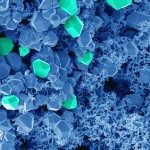About
Homologous DNA recombination (HR), universally initiating through invasion of one ssDNA strand into a duplex DNA molecule of similar sequence, is a central process of the biology of all living organisms, crucial both for genetic plasticity and genome maintenance . HR is catalyzed by a highly conserved recombinase, which acts in the form of a polymer assembled and disassembled along the exchanged DNA strands. Many other proteins are involved at different stages of HR reactions. A first category controls the initial interaction of the recombinase with ssDNA. These specialized proteins, named recombinase loaders, define the multiple HR pathways identified so far. The TRAM project aims to provide a molecular understanding of the newly identified specific HR pathway that operates during competence for genetic transformation in the human pathogenic bacterium Streptococcus pneumoniae (the pneumococcus).
Genetic transformation is a widespread bacterial process allowing genetic transfer, which is entirely controlled by the recipient cell. This process increases bacterial adaptability by promoting genome plasticity through intra-- and inter--species genetic exchange. In S. pneumoniae, it is presumably responsible for capsular serotype switching and could therefore reduce the efficiency of capsule--based vaccines. Genetic transformation proceeds through the capture of exogenous DNA, followed by its internalization in the form of single strands (ssDNA) and their incorporation into the host genome by HR. A specific multiprotein machinery, the transformasome, transiently synthesized and pre--assembled at the cell membrane of competent cells, processes the DNA, resulting in import across the cell wall and the membrane as well as the protection of the internalized ssDNA molecules. The transformasome also includes key effectors of the HR process. In the pneumococcus, these are the universal RecA recombinase and the DprA, SsbB, CoiA and RadA proteins. Our current knowledge on the mechanistic role(s) of these competence--induced proteins in HR is heterogeneous, with that of the later three being enigmatic. By contrast, the functional characterization of pneumococcal DprA led to a major breakthrough in recent years, with the demonstration that it acts as a loader of RecA on ssDNA in vitro, thereby revealing a HR machinery specific to the process of genetic transformation.
The aim of the TRAM project is to characterize the individual and concerted roles of the pneumococcal RecA, DprA, SsbB, CoiA and RadA proteins. This project will benefit from the partnership of three groups’ experts in different disciplines (biochemistry, electron microscopy, structural biology, molecular genetics, cellular biology) allowing a multidisciplinary approach. The main objectives of TRAM are: i) the characterization of the DprA--mediated mechanism of loading of RecA on ssDNA at the structural and molecular levels; ii) the biochemical analysis of SsbB functions in the early steps of transformational recombination, with the aim of understanding its role in RecA nucleofilamentation; iii) the molecular identification of the roles of CoiA and RadA in transformational recombination; iv) the in vitro characterization of protein interactions between these five protein v) the description of the dynamic subcellular localization of each of these proteins during competence, vi) the description of the dynamic subcellular localization of the internalized ssDNA, from its entry into the cell to its physical integration into the chromosome. Altogether, the TRAM project centered on these five proteins will generate a dynamic view of the assembly, function, and disassembly of the pneumococcal transformation HR machinery.

